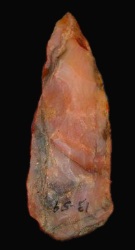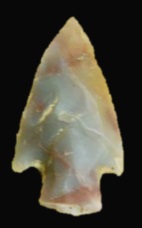Arkansas Novaculite
AKA: Potato Hill Novaculite,
Black Knob Ridge Novaculite, Caddo Gap Novaculite
Description of Physical Characteristics:
Color: Arkansas Novaculite
ranges from white to light
to dark grays and black, pinks to red, and tan to browns.
Normally, colors are light white, gray, pink, and yellow. less
commonly the color will be dark grays, black, reds, and yellows.
Texture: Very fine grain
Luster: Dull / matte to waxy or vitreous
Translucency: Translucent
Silica Fabrics / Fossils: Novaculite is a
microcrystalline to cryptocrystalline material consisting of silica. Typically no fossils
are present, but conodonts, sponge spicules, and radiolaria have been
reported.
Patina:
Heat Treatment: Heat treatment may have
no visual changes, however, red hues may occur (at specific temperatures).
Luster increases and there is an increase the flaking quality.
Knapping:
Distribution:
Distribution Comments:
Arkansas Novaculite is associated with the Devonian-Mississippian aged
Arkansas Novaculite Formation which is found along the Benton-Broken Bow
Formation of the Ouachita Mountains. It has primary outcroppings in McCurtian County Oklahoma (Potato Hills and Black Knob Ridge most
notably) and Montgomery County, Arkansas. May be found throughout
the Ouachita Mountains of Arkansas and Oklahoma.

Pictures Provided By:
Sara Beth Childs
References: (See Reference Page, Entry Number):
Similar Material:
Commonly made projectile point from this material:
Archaeological Context:
















